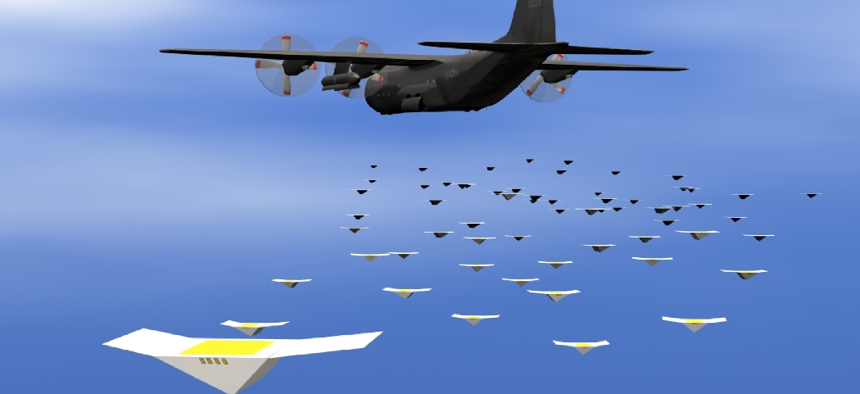Navy readies swarming micro-drones
CICADA, essentially a flying circuit board, is being readied for further testing.
Swarming drones serving as nodes in self-configuring sensor networks are being miniaturized to the point where individual autonomous craft amount to little more than flying circuit boards with a vertical stabilizer attached to a 3-D printed fuselage.
The U.S. Navy continues to push the state of the art, scaling individual swarming drones down to a palm-size craft called the Close-in Covert Autonomous Disposable Aircraft, or CICADA. The mini-drone under development at the U.S. Naval Research Laboratory (NRL), weighs in at just under 2.3 ounces.
The glider is guided by GPS and uses micro-electro-mechanical, or MEMS, pressure sensors to stabilize itself and maneuver in flight. Researchers claim CICADA is inherently stable in flight, with a glide ratio estimated at 3.5.
Glide ratio is a measure of an unpowered aircraft's forward motion during its descent. CICADA descends at a rate of about 1,000 feet per minute.
Up to 32 disposable vehicles can be packed into a canister fitted with a parachute to be launched from a P-3 Orion surveillance aircraft during upcoming flight tests. Once released in large numbers, NRL said, they can be used to "seed" an area with nodes as part of a self-configuring sensor network.
The micro-drones can be "placed in a programmable geometric pattern in hostile territory without directly over-flying those regions or exposing human agents on the ground," NRL said. Size is the glider's other major advantage, making them nearly impossible to detect while their sensors collect data as they slowly descend to the ground.
Early demonstrations of the sensor networks used high-altitude balloons to loft a mid-size drone that released the CICADA swarm. With development of a canister launcher, the decade-old basic research program is transitioning to the demonstration phase after the Naval Air Systems Command approved deployment from the P-3 Orion.
CICADA is part of an ongoing Pentagon effort to demonstrate and deploy "advance swarm behaviors" using micro- and mini-drones. Last fall, DoD's Strategic Capabilities Office in partnership with Naval Air Systems Command oversaw a test at China Lake, Calif. The third in a series of that began in September 2014 was designed to demonstrate adaptive flying formations and self-healing capabilities.
That test included 103 Perdix micro-drones released from three F/A-18 Super Hornets. The mini-aircraft were originally designed by Massachusetts Institute of Technology engineering students and modified for military use by MIT Lincoln Laboratory in 2013.




